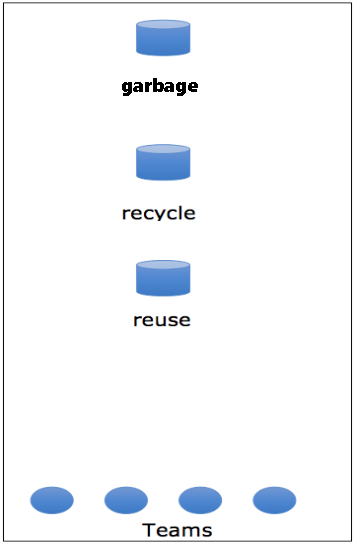Grade 5-12 (Science and Social studies)
Topic: How microplastics are polluting the environment and how to properly sort plastic waste
Time: 60 minutes
Space Requirement: Regular classroom and gym or outdoor area
Methodology: Class Discussion, Cooperative Learning, Exit Slips
Materials: Computers with Internet; a large number of various clean plastic items; rope or chalk; three boxes or bins labelled reuse, recycle and garbage; exit slips with the question “What is one action that you will take to reduce the amount of plastic you use?”
Objectives: Students will learn about microplastics and students will learn how to properly dispose of plastic items in their community
Directions/Procedure:
Ask students to give you the clean plastic items that they brought with them today (as requested last lesson).
Have students read the Microplastics Fact Sheet on SDWF’s website. (You can ask them to do this ahead of time if you wish.) While students are reading, put together a bag of plastic items for each group of four or five students in your class (if you have had them read the fact sheet ahead of time, put the bags together while they research online to learn which plastic types/items can be recycled in their community and which cannot). (10 mins)
Ask students about the effects of microplastics. Ask students whether they use any single-use plastics and how they could stop using single-use plastics. Ask students whether they think regulation should play more of a role. Ask students what can be done to reduce the amount of microplastics entering waterways and if none of the students mention it, say that properly managing plastic waste is a part of this. Tell students that it is best to reduce use of plastics in the first place but that if that is not possible they should reuse them as much as possible, then recycling them is the next best option, and finally putting them in the garbage is the only option that remains if nothing else can be done with the plastic items. (10 mins)
Divide students into groups of four or five. Then, have the groups of students research online to learn which plastic types/items can be recycled in their community and which cannot. (10 mins)
Set up the plastic sorting game as shown (note that you can use a rope or chalk if done on pavement to create a line that students must stand behind until the start signal) (2 mins):
6. At the start signal, the first person in line takes a plastic item from the bag, runs to the bin they think is appropriate for the item and places it in the bin. Then, the runner returns to their team and tags the next person in line. Continue, one runner at a time, until the team’s bag is empty. Team members sit down when all items are distributed in bins. The game finishes when all teams are seated. (10 mins)
7. Take the bins back to the classroom. Look at the plastic items in each of the bins and discuss:
Why were the bins placed at different lengths from the starting line?
Did the distances of the bins from the starting line make you think twice about which bin to choose?
Why was there no litter bin?
Do you agree with the choices groups made about what they put in the reuse, recycle and garbage bins? Why or why not?
What are some ways you can reuse the plastic items in the reuse bin?
Can all of the items in the recycling bin actually be recycled in our community?
Are there more environmentally friendly items we can substitute for some of the single-use plastic items?
How can we encourage businesses to reduce or replace plastic packaging?
How can you and your family reduce or replace plastic packaging?
(15 mins)
8. Give students the exit slips with the question “What is one action that you will take to reduce the amount of plastic you use?” Check the students’ exit slips as they leave the class at the end of the period. (3 mins)
Evaluation: Participation in the class discussions, whether they remembered to bring clean plastic items, their participation in the plastic sorting game, and their exit slips
Related Links:
Microplastics
Bottled Water
Aquifers
Emerging Contaminants
Extension Activity: The Safe Drinking Water Foundation has other educational programs that can be taught with this set of lessons. Operation Water Drop looks at what chemical contaminants there are in water and is designed for a science class. Operation Water Flow looks at how water is used and where it comes from and is designed for a Social studies and Math collaboration. Operation Water Spirit presents a First Nations perspective of water and water issues and is designed for a Native Studies class. Operation Water Health looks at common health issues surrounding drinking water in Canada and around the world and is designed for a Health, Science and Social Studies collaboration. To access more information on these and other educational activities visit the Safe Drinking Water Foundation website at www.safewater.org.


